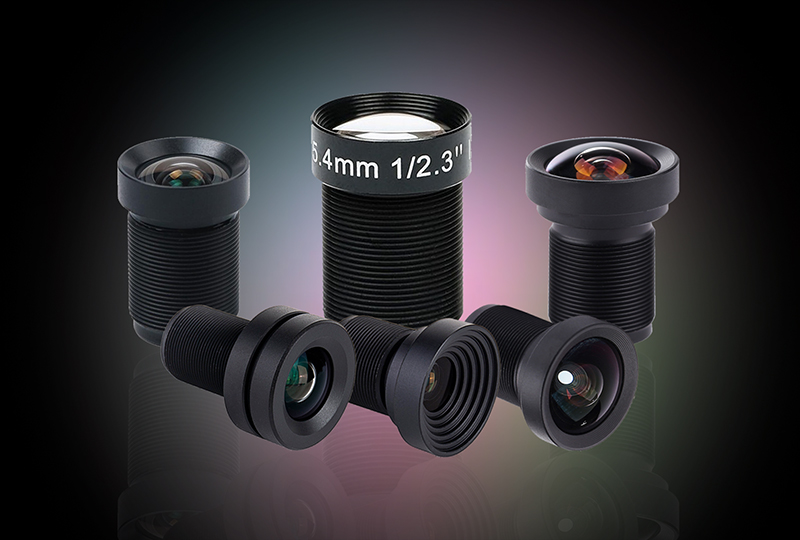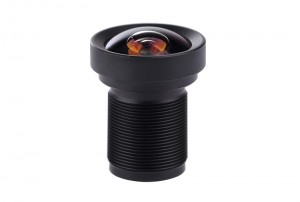|
Model |
CH1100EE |
|||
|
Type |
Low Distortion Lens |
Relative Ill. |
>75% |
|
|
Resolution |
8.8MP |
Chief Ray Angle |
<15° |
|
|
Image Format |
1/2.3″ |
M.O.D |
0.1m~∞ |
|
|
Image Circle |
ф8.1mm(MAX) |
Mount Type |
M12*P0.5 |
|
|
EFL |
4.35mm |
Dimension Figure |
ф14.0*L19.90mm |
|
|
TTL |
22.05mm |
Lens Structure |
4G2P |
|
|
F/NO. |
3 |
IR-Filter |
NDVI |
|
|
FFL(M) |
2.15mm |
Weight |
9.5g |
|
|
BFL(O) |
3.65mm |
Iris Operation |
Fixed |
|
|
For Sensor |
1/2.3″ |
Zoom Operation |
Fixed |
|
|
F.O.V |
Horizontal |
73º |
Focus Operation |
Manual |
|
Vertical |
56º |
Operating Temperature |
-20° ~+85° |
|
|
Diagonal |
86º |
Storage Temperature |
-20° ~+85° |
|
|
TV Distortion |
<-1.2% |
|||
This product was successfully added to cart!
NDVI Lenses
| Model | Sensor Format | Focal Length(mm) | FOV (H*V*D) | TTL(mm) | IR Filter | Aperture | Mount | Unit Price | ||
|---|---|---|---|---|---|---|---|---|---|---|
| MORE+LESS- | CH1100EE | 1/2.3" | 4.35 | 73º*56º*86º | 22.05 | NDVI | 3.0 | M12*P0.5 | $95Request Quote |
|
| MORE+LESS- | CH1100EC | 1/2.3" | 4.35 | 73º*56º*86º | 22.05 | IR660+850 | 3.0 | M12*P0.5 | $105Request Quote |
|
| MORE+LESS- | CH1100ED | 1/2.3" | 4.35 | 73º*56º*86º | 22.05 | IR475+850 | 3.0 | M12*P0.5 | $105Request Quote |
|
| MORE+LESS- | CH1100EF | 1/2.3" | 4.35 | 73º*56º*86º | 22.05 | IR550+660+850 | 3.0 | M12*P0.5 | $135Request Quote |
|
| MORE+LESS- | CH1100EG | 1/2.3" | 4.35 | 73º*56º*86º | 22.05 | IR475+550+850 | 3.0 | M12*P0.5 | $135Request Quote |
|
| MORE+LESS- | CH1100EH | 1/2.3" | 4.35 | 73º*56º*86º | 22.05 | IR490+550+808 | 3.0 | M12*P0.5 | $135Request Quote |
|
| MORE+LESS- | CH1117AD | 1/2.3" | 2.70 | 86º*70º*100º | 25.29 | NDVI | 2.8 | M12*P0.5 | $125Request Quote |
|
| MORE+LESS- | CH1117AE | 1/2.3" | 2.70 | 86º*70º*100º | 25.29 | IR550+660+850 | 2.8 | M12*P0.5 | $165Request Quote |
|
| MORE+LESS- | CH3769AG | 1/2.3" | 8.36 | 41.3º*31.8º*50.7º | 25.7 | IR550+660+850 | 2.8 | M12*0.5 | $165Request Quote |
|
NDVI (Normalized Difference Vegetation Index) is a commonly used index for measuring and monitoring vegetation health and vigor. It is calculated using satellite imagery, which measures the amount of visible and near-infrared light reflected by vegetation. NDVI is calculated using special algorithms applied to the data obtained from satellite images. These algorithms take into account the amount of visible and near-infrared light reflected by vegetation, and use this information to generate an index that can be used to assess vegetation health and productivity. However, some companies do sell NDVI cameras or sensors that can be attached to drones or other aerial vehicles to capture high-resolution NDVI images. These cameras use specialized filters to capture both visible and near-infrared light, which can then be processed using NDVI algorithms to generate detailed maps of vegetation health and productivity.
The lenses used for NDVI cameras or sensors are typically similar to the lenses used for regular cameras or sensors. However, they may have specific characteristics to optimize the capture of visible and near-infrared light. For example, some NDVI cameras may use lenses with a specific coating to reduce the amount of visible light that reaches the sensor, while increasing the amount of near-infrared light. This can help to improve the accuracy of the NDVI calculations. Additionally, some NDVI cameras may use lenses with a specific focal length or aperture size to optimize the capture of light in the near-infrared spectrum, which is important for accurate NDVI measurements. Overall, the choice of lens for an NDVI camera or sensor will depend on the specific application and requirements, such as the desired spatial resolution and spectral range.
Out of Stock
Products categories
-

Skype
-

Whatsapp
-

Top







 Products
Products





